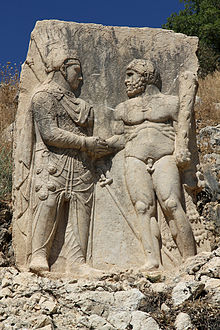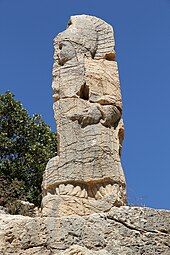Arsameia on Nymphaios
Arsameia am Nymphaios (Turkish name Eski Kale , German Old Castle) is an ancient city near Kocahisar (formerly Eski Kahta), Kâhta district in the Turkish province of Adıyaman . The ancient Nymphaios is today's Kahta Çayı . Arsameia was the royal seat of the Kingdom of Commagene . It is best known for the Hierothesion of King Mithridates I Kallinikos, which his son and successor Antiochus I built for him there.
history
Coordinates: 37 ° 56 ′ 34 ″ N , 38 ° 39 ′ 25 ″ E
Arsameia was founded in the third century BC. Founded by the Armenian King Arsames (255–225 BC). This took 235 BC. BC the Seleucids Antiochus Hierax on his flight from his brother Seleukos II , who was later referred to as his ancestor by the Commagenic King Antiochus I. The city was already abandoned in Roman times, stones from the grave structures there were used by Roman soldiers to build bridges.
Hierothesion
The Greek word Hierothesion ( ἱεροθέσιον ) is a name known only from Commagene for the sacred burial area of members of the royal family. In addition to the hierothesion that Antiochus built himself on Nemrut Dağı , and the second on Karakuş , which his son Mithridates II built for the female members of the royal family, there is the third in Arsameia, the tomb and the associated cult area for Antiochus' father Mithridates. A processional path leads up the mountain in a Z-shape and passes three places that the explorer Friedrich Karl Dörner designated with plinths I-III . On the first of these, base II, there is the fragment known as the Mithras relief. It is the right part of a dexiosis that shows Antiochus or Mithridates shaking hands with the sun god Mithras . With this type of representation, which is widespread throughout the Commagene, Antiochus puts himself and his relatives on a par with the gods. Dörner was able to raise the lower and upper parts of the Mithras half again, only a shoulder part of the left half was found, which Dörner identified as one of the two kings based on the clothing.
At the first bend in the path there is a base system I. Here you can also see the remains of depictions of dexiosis, but the people who were depicted could not yet be identified. In addition, a hall has been carved into the rock here, from which 14 steps lead down to another nine meter high and about eight by eight meter large room. Its function is unclear, Dörner considers it a Mithras cult site, other archaeologists suspect the burial place of Mithridates here.
The path continues to the base system III. Here you can find the five-column inscription of Antiochus on a rock wall, in which he reports on the founding of the city and the construction of the Hierothesion and also issues detailed regulations for the performance of the ritual acts to be performed. Since the inscription has been almost completely covered by earth since ancient times, it is in excellent condition. In the lower part of the writing wall begins a corridor driven diagonally downwards into the rock, which ends blind after 158 m. Nothing is known about its function. Above the wall is the best preserved dexiosis relief by Kommagene. It shows one of the two kings Antiochus or Mithridates shaking hands with the naked Heracles , identified by a club.
From this base the processional path continues to the top of the mountain. Building foundations with mosaic floors were found there, which can be dated to the second century BC. On the basis of sculpture fragments, Dörner assumes that the tomb of Mithridates, decorated with statues, stood here.
Yenikal and pigeon castle
About two kilometers away, on the other side of the Kahtaçay, is Yenikal Castle (German New Castle) . According to the inscription, the palace buildings of the Commagenic rulers were located at base III. Today you can see a Mamluk castle there. Inside there are building and restoration inscriptions by the sultans Kala'un (1279–90), Ashraf Chalil (1290–93) and Nasr Mohammed (1293–1341). However, it has been proven that a previous building was conquered and destroyed by Kara Sonkar, the governor of Aleppo , as early as 1286 . From the lower castle on the side facing the river, a corridor leads to a building called a pigeon castle , which is built under an overhanging rock ledge. It served to supply the castle with water and, via a bridge, the Eski Kale. On the upper floor there is a room set up as a pigeon station with a rectangular entrance hole and 32 niches as nesting places. It was used as a means of transmitting communications as early as the 13th century, when Sultan Kala'un received information about troop movements by the opposing Mongols before the Battle of Homs .
Eisenfeld
To the west of the two mountains of Yenikal and Eskikal, Dörner and his colleague Wilhelm Winkelmann discovered an iron smelting district in a field, the first in Kommagene. Remains of furnace walls, pieces of slag, furnace sows (remnants of pig iron during iron extraction), but also shards and coins were found.
Research history
In the course of researching Nemrut Dağı, the German archaeologist Friedrich Karl Dörner was made aware of a picture stone by locals in 1951 . During the investigation, this turned out to be the relief with the Mithras depiction of base system II. When he then found the writing wall of base III and was able to read it immediately because of its good state of preservation, he was able to identify the place as the commagenic residence city of Arsameia. In 1953 he received the first excavation permit. Together with the American Theresa Goell , he uncovered the finds visible today in the years 1953–56. From 1963 excavations took place again. Some of the finds are exhibited in the Gaziantep Archaeological Museum .
Individual evidence
- ↑ Gernot Lang Classical Ancient Sites Anatolia: Classical Ancient Sites Anatolia I u. II Books on Demand, 2003 , ISBN 3833000686 , p. 198.
- ↑ Marianne Mehling (ed.): Knaur's cultural guide in color Turkey . Droemer-Knaur 1987 ISBN 3-426-26293-2 , p. 26f.
- ↑ Friedrich Karl Dörner The Throne of the Gods on Nemrud Dağ 2nd edition Gustav Lübbe 1987, ISBN 3-7857-0277-9 , p. 213f.
literature
- Friedrich Karl Dörner, Theresa Goell: Arsameia am Nymphaios: The excavations in the Hierothesion of Mithradates Kallinikos from 1953-1956 . Gebr. Mann, 1963, ISBN 3803017548 .
- Friedrich Karl Dörner : The throne of the gods on the Nemrud Dağ. Kommagene - the great archaeological adventure in Eastern Turkey. 2nd, expanded edition. Gustav Lübbe, Bergisch Gladbach 1987, ISBN 3-7857-0277-9 .
- Helmut Waldmann: The commagenic cult reforms under King Mithradates I. Kallinikos and his son Antiochus I. Brill, Leiden 1973, ISBN 90-04-03657-1 at GoogleBooks .
- Reinhold Merkelbach : Mithras: A Persian-Roman mystery cult . Walter de Gruyter, 1994, ISBN 3895470457 on GoogleBooks .
- Michael Blömer, Engelbert Winter : Commagene. The Land of Gods Between the Taurus and the Euphrates. An Archaeological Guide (= Homer Archaeological Guides. Volume 11). Homer Kitabevi, Istanbul 2011, ISBN 978-9944-483-35-3 , pp. 76-91.






